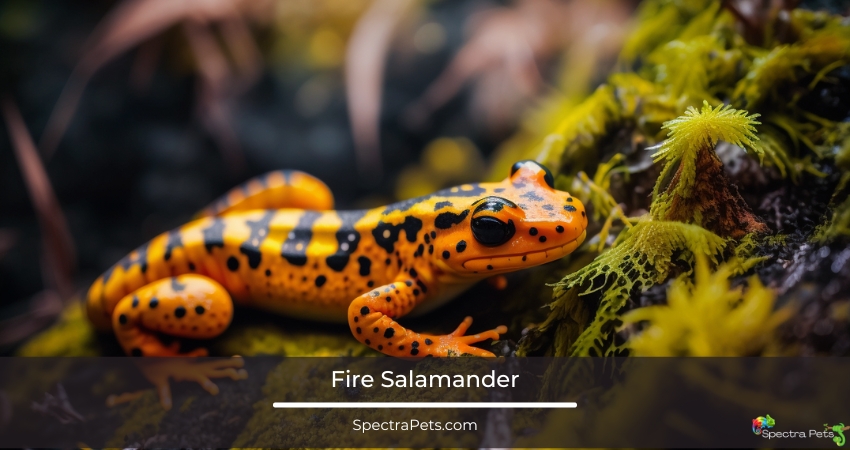I’ve noticed that salamanders have been considered symbolic in many traditions and cultures. For example, in Ancient Greece, even before the time of Aristotle, salamanders were thought to be an avatar for Apollo, while europeans believed they’re winged animals covered in flames.
Wait that sounds like a phoenix, doesn’t it? Here’s a fun fact: salamanders have been linked with rebirth, immortality, good fortune in old chinese texts, just like the phoenix. The message is clear: salamanders have existed before many civilizations, and therefore, have been associated with events and objects in various ways.
But the most they have been associated with is fire. “For what reason?” that question might pop up in your head. Luckily, that’s what I’m gonna talk about today…
Does The Salamander Represent Fire?
In the past, it was a common misconception that salamanders were born in fires. Perhaps this is the case because salamanders frequently hide under logs, and when those logs were gathered to make a fire, salamanders scurried away from the flames.
There are also several other cultural and mythical associations between salamanders and fire. In ancient mythology, people believed salamanders to be creatures of fire and to have the ability to control and manipulate flames. This belief was likely based on the fact that salamanders are often found near bodies of water, which can help to extinguish fires.

Another reason for the association between salamanders and fire is the fact that they are able to regenerate their limbs. This ability has led to the belief that salamanders have a special connection to fire and that they are able to withstand and even thrive in the presence of flames.
In addition to their regenerative capabilities, salamanders also possess the unique ability to secrete slimy mucus from their skin. This mucus has a high water content, which can help protect the salamander from the drying effects of fire.
Salamanders And Fire: Historical Context
Salamanders have been a subject of fascination and intrigue for centuries. Their mysterious nature and unique abilities have led to a myriad of myths and legends.
- Ancient Greece: Salamanders were revered and often associated with Apollo, the god of sun and light. They were seen as avatars of this powerful deity.
- Europe: The belief that salamanders were winged creatures engulfed in flames was prevalent. This association with fire was both awe-inspiring and fearful.
- China: Ancient texts often linked salamanders with rebirth, immortality, and good fortune, drawing parallels with the legendary phoenix.
Dr. Helena Grant, a historian specializing in ancient cultures, states, “The salamander’s association with fire is deeply rooted in ancient beliefs. Their ability to emerge unscathed from flames was seen as a divine sign, leading to their reverence in various cultures.”
What Does The Salamander Symbolize?
In ancient mythology and culture, salamanders have a number of symbolic meanings. There are many different adaptations. Below, I will try to enlighten you on the most common ones:
Fire
As mentioned above, the salamander is often linked with fire due to its presence near bodies of water, which can serve as a natural firebreak, and its ability to regenerate its limbs. In many cultures, the salamander is seen as a symbol of fire and is believed to have the ability to control and manipulate flames.
Transformation
In many cultures, the salamander is seen as a symbol of transformation due to its ability to regenerate its limbs. This has led to the belief that salamanders have a special connection to fire and that they are able to withstand and even thrive in the presence of flames.
Healing Powers
The salamander’s ability to regenerate its limbs has also led to the belief that it has special healing powers. In some traditions, the salamander is seen as a symbol of renewal and rejuvenation and is believed to have the ability to heal both physical and emotional wounds.
Water and Rain
In some traditions, the salamander is also seen as a symbol of water. This is because of their prevalent habitats near water bodies and their moist skin, which can repel the drying effects of fire. Additionally, there is the belief that the salamander is able to bring rain and other forms of good fortune.
Salamanders also represent good luck, passion and the cycle of rebirth.
Cultural anthropologist Dr. Liam Foster notes, “Salamanders, in their silent, elusive ways, have influenced human beliefs and traditions in profound ways. Their symbolism transcends borders and epochs.“
Are Salamanders Resistant To Fire?
So, their unique association with fire might lead to the question, “Can salamanders survive fire?” or “Are salamanders fireproof?”
Salamanders are not resistant to fire in the sense that they can withstand direct exposure to flames without being harmed. However, they do have several adaptations that allow them to survive in environments where fires are common.
One adaptation that helps salamanders survive in areas prone to fire is their ability to regenerate their limbs. This means that if a salamander loses a limb in a fire, it has the ability to regrow the limb, just as a phoenix is said to rise from the ashes.
The ability of salamanders to exude a slimy mucus from their skin is another characteristic that sets them apart from other animals in terms of regeneration. Due to the high water content of this mucus, it can help shield salamanders from the drying effects of fire.
Salamanders are also often found near bodies of water, which can serve as a natural firebreak. This means that they are often able to survive wildfires that ravage their habitats.
Why Are Fire Salamanders Called “Fire Salamanders?”
So, naturally, you may think, surely the fire salamander has its name because of a closer association with fire. Well, that’s not the case! Let’s find out the reasons behind the naming of this species.

Fire salamanders (Salamandra salamandra) are a species of salamander that is native to Europe. They are named for their bright colors, which are typically black, yellow, or orange, and are thought to help the fire salamander blend in with its surroundings, as well as serve as a warning to predators.
Fire salamanders are often found near bodies of water, which can serve as a natural firebreak. This means that fire salamanders are often able to survive wildfires that ravage their habitats.
In addition to their presence near bodies of water, fire salamanders are also known for their ability to regenerate their limbs.
This unique characteristic has led to the belief that fire salamanders have a special connection to fire and that they are able to withstand and even thrive in the presence of flames.
Scientific Explanation Behind the Association
Salamanders are a type of amphibians that are known for their unique characteristics and adaptations. Let’s learn more about these special traits first:
Regeneration
One of the most notable things about salamanders is their ability to regenerate their limbs. This means that if a salamander loses any body part, it has the ability to fully regrow the lost part and completely heal from the injury. This trait, rare in the animal kingdom, has contributed to their association with rebirth and fire.
Protective Mucus
Salamanders are also known for their ability to secrete a slimy substance called mucus from their skin. This mucus has a high water content, which can help protect the salamander from the drying effects of fire. It is also thought to have antimicrobial properties, which may help protect the salamander from infections and other forms of harm.
Dr. Jane Mitchell, a herpetologist, mentions, “The mucus secreted by salamanders is not just a protective mechanism. It’s a complex substance that has intrigued scientists for its potential medicinal properties.“
Environmental Adaptability
These amphibians are found in a wide range of environments, from forests and wetlands to deserts and mountains. They are able to adapt to a variety of conditions, including cold temperatures, high elevations, and dry environments.
Species Near Fires
Some salamander species, like the Fire Salamander, are often found near fire-prone areas. Their habitats and behaviors have further solidified their association with fire.
Myth vs. Reality (Newly Added)
While myths add a touch of magic to the salamander’s narrative, it’s crucial to distinguish fact from fiction.
- Myth: Salamanders can survive direct exposure to flames.
Reality: While they have adaptations to survive in fire-prone areas, direct exposure can harm them. - Myth: Salamanders are born from fire.
Reality: This belief likely arose from observing salamanders scurrying away from logs set on fire.
Dr. Rachel Gomez, a herpetology researcher, says, “While salamanders are fascinating, it’s essential to approach their abilities with a scientific lens. Their association with fire, though rooted in observation, has been exaggerated over time.“
Frequently Asked Questions
Why are salamanders often found near fires?
Salamanders often reside under logs and in damp places. When these logs are used for fires, the salamanders are forced to flee, leading to the misconception that they emerge from the flames.
Are all salamander species associated with fire?
No, while the Fire Salamander is the most commonly associated species, not all salamanders have a direct link to fire.
How do salamanders regenerate their limbs?
Salamanders possess unique cells called blastemal cells, which proliferate and differentiate to form new tissues during the regeneration process.
Wrapping Up
Salamanders have been closely linked with fire for more than many of our lifetimes combined. And looking at all the reasons, I do think it’s somewhat justified. This connection will continue for many years to come.
After knowing the truth about Salamanders and fire, you should have a better understanding of why people associate them with it. Feel free to comment on this topic if you have any more interesting information to share.

